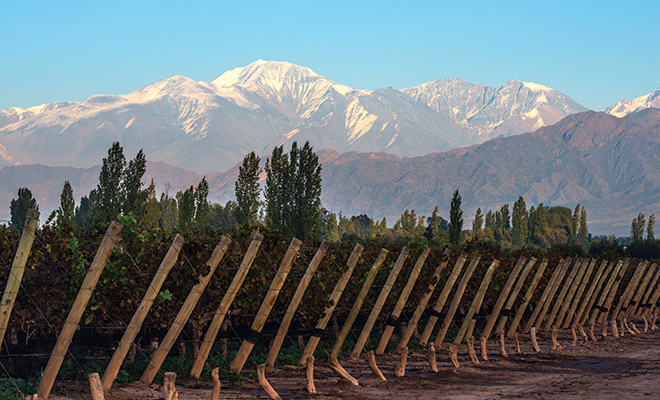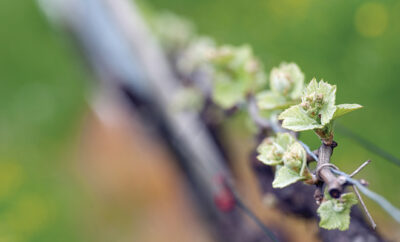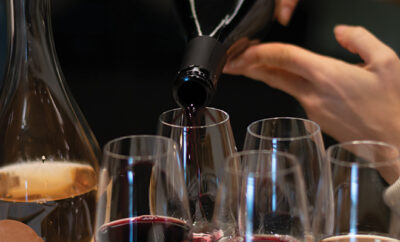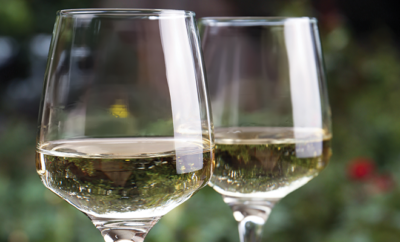
Argentina in Your Glass
May I have a glass of Argentina, please? When you visit the fine restaurants today, you can’t help but notice all the wine offerings coming from the beautiful region and culture of Argentina. Whether you’re in a neighborhood bistro or a hip wine-bar, the wines offered by the glass and by the bottle are impressive for flavor and value.
When immigrants came to Argentina in the early 1900s from Italy and Spain, they brought the diverse love of wine growing with them to establish what is now the fifth-largest wine producing region of the world. The astonishing altitude of the vineyards creates a challenging climate that affects the style of every wine. The highest peaks of the Andes Mountains are 20,000 feet in elevation, with blades of ice and rock. Where the vineyards flourish, the vines enjoy overnight temperatures that are low enough to protect the deepest-colored grapes for full-bodied red wines and aromatic white wines. The wine-loving audience in the United States has embraced this market with open arms. With wines from Argentina, we are enjoying both history and culture paired for our enjoyment.
From the region of Mendoza, we enjoy malbec, barbera, tempranillo, sangiovese, cabernet sauvignon, syrah and white wine varietals of torrontés, chenin blanc, semillon and chardonnay. Malbec is what many say is the signature wine of this region. Brought to Argentina in 1868, the grape grew in smaller, tighter bunches in Mendoza than in the vineyards of southern France. This produces a wine with intense flavor and great acidity, making it hold up and pair with food.
Bonarda by any other name is charbono! If you’re the wine person in your group, pick up a bottle or two for a tasting and you may agree with some of the current wine experts who believe that bonarda is the next big thing to hit the market in the red category. After malbec, the second most planted grape varietal in Argentina is bonarda, which provides a low-tannin, beautiful red wine with a dark plum, dark cherry profile with allspice thrown in for fun. This delicious and flavorful wine ages well and will develop a sense of violet as the fruit ripens and smooths out. If you like the friendly factor of merlot and how it goes with nearly everything, you will enjoy trying a bonarda. Here in the U.S., this varietal is grown as charbono, planted mostly in Napa Valley, California, since the 1940s. Charbono is primarily used as a blending grape to create fruit and acidic balance in wines.
Let’s explore a fresh and aromatic wine from Argentina, torrontés. Evoking light stone fruit such as peach and apricot, this wine is smooth on the palate without having a heavy, sweet, fruit finish. Nearly every region has a grape varietal that truly expresses its unique location and climate, and torrontés is that signature grape that many believe flourishes as its best expression in Argentina, where the vines thrive in mountainous areas. The Argentine Wine Producers Association often uses the beautiful torrontés wines as an ambassador for the region, introducing new markets to this signature white wine that receives many international awards.
Another beautiful wine that may be enjoying some well-earned attention is semillon. Well known in the U.S. and rarely bottled as a single varietal, semillon (pronounced sem-e-jon in Argentina) is enjoying a resurgence in popularity among vintners and wine consumers after 30 years of playing second and third fiddle to more popular chardonnay and torrontés. Today, this lovely, complex white wine delivers a jasmine and honey profile without the overt sweetness one would assume. Blended on its own or with sauvignon blanc, chenin blanc or chardonnay, the result is a balanced wine for appetizers, fish and cheeses.
What’s wonderful about the entire wine-growing region within Argentina is the diversity of mountain terrain, desert plains, ice-cold glacier temperatures and moisture-rich wooded areas that provide a cross section of influence. The result is unique wines that have a sense of place in each glass. Four distinct wine regions provide wine enthusiasts a plethora of taste, culture and nuances unique to each region within the country.
When looking at the wine labels to select your next wine adventure, look for growing regions of Catamarca in the north region, La Rioja and Mendoza in the Cuyo region, Buenos Aires in the Atlantic region, and Rio Negro and Chubut in the Patagonia region. Patagonia is the southernmost wine producing area, with a dry and cool climate that yields white wine grapes such as gewürztraminer, riesling and semillon.
If traveling to Argentina for the holidays wasn’t on your wish list for Santa, treat yourself to a little festive holiday fun and try a wine from Argentina. It’s like traveling for the holidays without a passport! ■
Sources: decanter.com, snooth.com, winefolly.com and wine-searcher.com.







